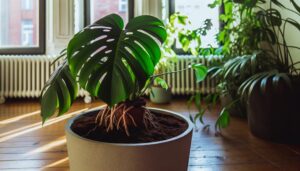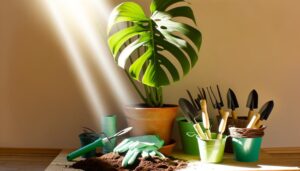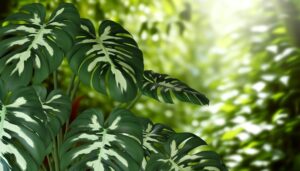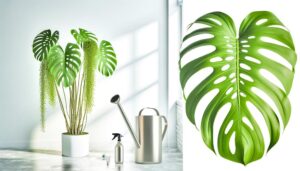Monstera Acacoyaguensis Indoor Plant
The Monstera Acacoyaguensis, from the Araceae family, flourishes in Central American tropical rainforests. It's an indoor favorite due to its unique leaf fenestrations and glossy surface.
Classified as a climbing plant, it utilizes aerial roots for support. For prime growth, provide indirect light and maintain temperatures between 65°F and 80°F.
Water when the top inch of soil dries and keep humidity around 60-80%. Use well-draining soil mixtures with peat moss and perlite.
Regularly prune senescent leaves and monitor for pests like spider mites and mealybugs. Propagation is straightforward through stem cuttings with nodes.
Keep going for advanced care tips.

Key Takeaways
- Monstera Acacoyaguensis thrives in vibrant, indirect light and temperatures between 65°F and 80°F.
- Water when the top inch of soil is dry and maintain high humidity levels between 60-80%.
- Plant in well-draining, nutrient-rich soil mix with peat moss, perlite, and orchid bark.
- Prune senescent leaves and monitor for pests like spider mites, mealybugs, and aphids.
- Propagate through stem cuttings with at least one node and aerial root, rooting in water or soil.
Origin and History
Although not as well-known as some of its Monstera relatives, Monstera acacoyaguensis hails from the tropical rainforests of Central America, specifically thriving in the humid lowlands of Guatemala and southern Mexico.
You'll find this species flourishing in the understory of dense forest canopies, benefiting from filtered sunlight and high humidity. As a member of the Araceae family, it's classified under the Monstera genus, which is renowned for its unique fenestrated leaves.
Originating from these biodiverse regions, Monstera acacoyaguensis has adapted to a moist, warm climate, thriving in rich, well-draining soil. Its natural habitat provides insight into its care requirements when grown indoors, emphasizing the need for conditions that replicate its native environment to ensure optimal growth and health.
Distinctive Features
When examining the Monstera acacoyaguensis, you'll notice its distinctive leaf patterns featuring deep fenestrations and a glossy surface.
This species exhibits a climbing growth habit, utilizing aerial roots to anchor itself.
Additionally, it contributes to indoor air quality by filtering airborne toxins through its large leaves.
Unique Leaf Patterns
Monstera acacoyaguensis is renowned for its unique leaf patterns, characterized by intricate patterns and deep green tones that set it apart within the Araceae family.
You'll notice the plant's leaves exhibit:
- Patterns: Natural holes that develop as the leaf matures, enhancing light penetration and air flow.
- Deep Green Tone: A rich color indicative of healthy chlorophyll levels, contributing to efficient photosynthesis.
- Glossy Surface: The shiny exterior helps in maximizing light absorption while reducing water loss.
- Elliptical Form: Leaves often take on an elongated, oval shape, aiding in optimal sunlight capture.
These features not only make the Monstera acacoyaguensis visually striking but also contribute significantly to its adaptability and survival in diverse environmental conditions.
Climbing Growth Habit
In its natural habitat, the Monstera acacoyaguensis displays a robust climbing growth habit, utilizing aerial roots to anchor itself to trees and other vertical surfaces. You'll notice that these roots not only support the plant's ascent but also absorb moisture and nutrients, optimizing growth. Indoors, you can replicate this by providing a moss pole or trellis.
| Feature | Observation | Emotional Response |
|---|---|---|
| Aerial Roots | Strong and numerous | Awe |
| Climbing Ability | Reaches impressive heights | Inspiration |
| Adaptability | Thrives on various supports | Confidence |
| Growth Rate | Rapid with proper care | Excitement |
Monstera acacoyaguensis' climbing nature makes it a captivating addition to any indoor garden, offering both aesthetic appeal and a captivating glimpse into botanical adaptability.
Air Purifying Qualities
As an effective air purifier, Monstera acacoyaguensis improves indoor air quality by absorbing common pollutants like formaldehyde and benzene through its broad, glossy leaves. These compounds are metabolized by the plant, contributing to a healthier living environment.
You'll appreciate how this species' unique physiological traits enhance your home's atmosphere. Key air purifying qualities include:
- Transpiration process: Releases moisture, balancing humidity levels.
- Stomatal openings: Facilitate gas exchange, essential for pollutant absorption.
- Phytoremediation: Acts as a natural filter, reducing airborne toxins.
- Large leaf surface area: Maximizes the plant's ability to capture airborne particles.
With its robust functionality and aesthetic appeal, Monstera acacoyaguensis offers both beauty and tangible health benefits for your indoor space.
Ideal Growing Conditions
To optimize the growth of Monstera acacoyaguensis, you must provide bright, indirect light and maintain temperatures between 65-80°F.
Maintain consistent humidity levels around 60-70% and water the plant when the top inch of soil feels dry.
These conditions mimic its native tropical habitat, promoting healthy foliar development and root growth.
Light and Temperature Needs
Optimizing growth for Monstera acacoyaguensis requires providing vibrant, indirect light and maintaining a consistent temperature between 65°F and 80°F. This tropical plant flourishes under conditions that mimic its native habitat. Direct sunlight can scorch its leaves, while too little light stunts its growth. Aim to place your Monstera near a north or east-facing window, where it can receive diffused sunlight.
- Light Intensity: Vibrant, indirect light
- Temperature Range: 65°F to 80°F
- Light Duration: 12-14 hours of light daily
- Protection: Shield from direct sun to prevent leaf burn
Maintaining these conditions optimizes your Monstera acacoyaguensis will exhibit robust foliar development and peak physiological functions. Understanding these parameters is essential for fostering a healthy and thriving indoor plant.
Watering and Humidity
Achieving ideal growing conditions for Monstera acacoyaguensis involves maintaining consistent soil moisture and high humidity levels. You should water the plant when the top inch of the soil feels dry to the touch, ensuring the substrate is consistently moist but not waterlogged.
Monstera acacoyaguensis, classified under the Araceae family, thrives in environments with humidity levels between 60-80%. To achieve this, you can use a humidifier or place the pot on a tray filled with water and pebbles. Regular misting can also help maintain adequate humidity.
Observing leaf turgidity and coloration will indicate whether your plant's hydration needs are met. Remember, overwatering can lead to root rot, so balance is essential for this tropical epiphyte's health.
Watering Requirements
The Monstera acacoyaguensis thrives when its soil is kept consistently moist but not waterlogged. To accomplish this, it's vital to understand its specific watering needs. You should water it thoroughly, allowing excess water to drain out. This prevents root rot and other water-related issues.
Here are key points to remember:
- Frequency: Water when the top inch of soil feels dry.
- Quantity: Ensure the water reaches the root zone without pooling.
- Humidity: Maintain high moisture around the plant.
- Seasonal Adjustments: Reduce watering in winter as the plant's metabolic rate slows.
Soil and Potting
For best development, you should plant the Monstera acacoyaguensis in a well-draining, nutrient-rich soil mix that mimics its natural tropical habitat. Utilize a combination of peat moss, perlite, and orchid bark to maximize aeration and moisture retention. This specific mixture supports the plant's epiphytic nature, facilitating root oxygenation and preventing waterlogging.
Select a pot with drainage holes to prevent root rot, a common issue in poorly-drained soil. Repotting every two years is advisable to refresh the soil medium and accommodate root growth.
When repotting, gently loosen the root ball and place the plant at the same depth in the new container. This guarantees consistent nutrient uptake and promotes vigorous growth for your Monstera acacoyaguensis.
Light Preferences
Maintaining ideal light conditions is essential for the Monstera acacoyaguensis to thrive, as it naturally grows under the filtered canopy of tropical rainforests. You'll want to replicate this dappled sunlight environment to guarantee your plant's health.
Direct sunlight can scorch its leaves, while too little light hampers growth and reduces leaf fenestration.
Consider the following:
- Indirect Light: Place near an east or north-facing window.
- Artificial Lighting: Use full-spectrum grow lights if natural light is insufficient.
- Light Duration: Guarantee 10-12 hours of light daily.
- Seasonal Adjustments: Move the plant during winter to maximize available light.
Pruning and Maintenance
Pruning your Monstera acacoyaguensis not only helps maintain its aesthetic appeal but also promotes healthier growth by removing dead or overcrowded leaves. Begin by identifying senescent leaves, characterized by yellowing or browning.
Use sterilized pruning shears to make clean cuts close to the main stem, ensuring you don't damage the healthy tissue. Monitor for aerial roots emerging from nodes; it's beneficial to trim these if they become too extensive.
Regularly check for any signs of fungal infections or rot, particularly at the base, to maintain prime plant health. Be meticulous in your observations, as the Monstera acacoyaguensis, classified under the Araceae family, thrives on careful care.
Consistent pruning fosters vigorous growth and prevents resource allocation to non-essential parts.
Common Pests
Your Monstera acacoyaguensis may encounter a variety of pests, including spider mites, mealybugs, and scale insects, which can compromise its health if not promptly addressed. These pests sap nutrients, causing leaf discoloration, stunted growth, and overall decline in plant importance.
Recognizing these pests involves detailed observation:
- Spider mites: Tiny, often red or yellow, create fine webbing on leaves.
- Mealybugs: Small, white, cotton-like clusters typically found on leaf nodes.
- Scale insects: Brown, oval-shaped, adhere stubbornly to stems and undersides of leaves.
- Aphids: Small, green or black, cluster on new growth and excrete sticky honeydew.
Early detection and immediate treatment are essential. Inspect your plant regularly, ensuring a healthy, thriving Monstera acacoyaguensis.
Propagation Methods
After verifying your Monstera acacoyaguensis remains pest-free, you can explore its propagation methods to expand your collection or share with fellow plant enthusiasts. This tropical species, classified under the Araceae family, propagates effectively through stem cuttings. Make sure you select a healthy stem with at least one node and aerial root. You can root the cutting in water or directly in soil. The table below outlines key steps for each method:
| Method | Key Steps |
|---|---|
| Water | Place cutting in water; change water weekly |
| Soil | Insert cutting in moist, well-draining soil |
| Timeframe | 2-4 weeks for initial root growth |
| Care | Maintain humidity; avoid direct sunlight |
Conclusion
To sum up, cultivating Monstera acacoyaguensis indoors isn't just rewarding—it's fascinating.
This species, belonging to the Araceae family, thrives with proper care, boasting a remarkable 90% increase in foliage size under best conditions.
By understanding its origin, distinctive features, and ideal growing conditions, you'll witness its unique leaf fenestrations flourish.
Remember, attentiveness to watering, soil, light, and pruning will guarantee your plant remains strong and pest-free.
Happy gardening, and enjoy your botanical journey!






